It is a tale as old as time; a song as old as rhyme: beauty and the beast!
Ahh, Beauty and the Beast, the classic fairytale of someone being a jerk and sort of getting what’s coming to them. Not really, even though we all loved to dislike Gaston. The complexities of the original story go much deeper than the fabricated Gaston subplot, instead focusing on love, acceptance, forgiveness, humility, and understanding.

Written in 1756 by French novelist Jeanne-Marie Leprince de Beaumont (a female French writer during the Seven Years War? Respect!), the story has become a classic around the world and has spawned many ideas and themes, which later authors and filmmakers have gladly co-opted for their own use.
Of course, the story was also made into a top-notch Disney movie that actually may have made a difference for women’s rights and the ideas of inclusion over exclusion. But if we take the film at face value and do not dig any deeper than to gaze at its animated surface, we would see a story about someone beautiful (Belle) with someone, well, not-so-beautiful (Beast). Then we would see the kind but not-so-beautiful Beast become beautiful (or, gender appropriately, handsome) after Belle tells him she loves him.
Simplistic explanation aside, for many it was tears, sniffles, and one great big happily-ever-after.
For me, it’s a small reminder of how something incredibly beautiful, like, say, a watch perhaps, might not fit the profile of proper wrist wear for anyone other than a beautiful, usually female, WIS.
This makes me very aware of what people may think if this nerd writer (a.k.a. Beasty McWatchguy) were to say, “I really, really would love to wear the Hermès Arceau Temari myself because it is so utterly beautiful and classy.” People might do a spit take.
So, seriously, you’d wear a women’s watch?
Yup, I would wear a women’s watch. The Arceau Temari is Hermès’ incredible take on embroidered Japanese temari balls combined with hard stone marquetry and diamond snow setting.
The result, clearly, is a mesmerizing visual feast.
But what exactly makes this watch so fantastic that I would gush over it, especially since it only displays hours and minutes in a very normal way, with a very straightforward movement? The answer is skill.
This watch is an exhibition of skill, not mechanical wizardry or engineering excellence per se, but above all artistic skill that is yet presented in something hard, concrete, and easy to enjoy.
Many of the métiers d’art (artistic crafts) displayed in watches such as hand engraving, cloisonné enamel, miniature painting, millefiori crystalwork, stone setting, and others are presented as magical creations by master craftsman and artists. This remains true, of course, but there is something a little more understandable (maybe only to myself) about hard stone marquetry, especially as it is shown in this instance.
Hard stone marquetry is traditionally called pietra dura after its historic Italian origins meaning “hard rock.” Glamorous name notwithstanding, pietra dura refers to all artistic carving of semi-precious stone, under which hard stone marquetry falls. It should not be confused with mosaics, which usually constitutes an image made from a group of roughly similar-sized and -shaped stones that have no truly distinct shape.
With hard stone marquetry, the stones are usually much larger (obviously a relative term for us in this case) and shaped very precisely to make up an entire shape or object instead of bits assembled to a rough shape. Each stone has its place; this is just a different process with a different goal in mind.
This process is one I can understand even before I hear more about it. I may never fully understand how to carefully add a gradient to some transparent enamel, but I can understand cutting and shaping a stone to an exact, desired shape.
It’s pretty straightforward, if extremely difficult. An artist takes a stone that he or she wants to use, slices it on a diamond saw into a thin sheet, and then slices that sheet into an approximate shape. Then, using extremely hard diamond files and abrasives, the edges are worked until the stone is the required shape, be it a star, square, or a cute little squirrel.
Modern technology has made this even more scientific with the introduction of CNC milling with diamond cutters, computer-controlled wire saws, and waterjet cutting. But the process is not without problems, the main hazard being complete instantaneous structural failure, otherwise known as shattering.
Incredibly annoying and frustrating
The reason for shattering is brittleness. Ceramics are extremely hard, which you might already know from all the ceramic bezels and cases popping up all over the industry. This hardness leads to a weak spot, literally, in that even the toughest ceramics will, when hit with the right force at the right spot, shatter due to the material’s inability to deform like plastic or metal.
So at any point in the cutting and shaping process the material could shatter, and the work would need to be started from scratch.
For the Arceau Temari, a thin slice of either white mother-of-pearl, onyx, lapis lazuli, or opal is cut and then lapped to an even thickness and fairly polished surface. Next, the prepared slice is CNC-milled to obtain the desired shapes, in this case being representations of the geometric patterns from the silk scraps on a temari ball. Then the pieces are re-polished and hand-finished, achieving the perfected final shape. These shapes are then inserted into pockets in the white gold dial blank and attached using an adhesive.
Rock nerd side-note: lapping is the process by which a somewhat flat piece of hard material, in this case stone, is abrasively ground by rubbing it against another hard material with an abrasive mix between the two, achieving an extremely flat and smooth surface. This is technically the same process that lens makers use to create perfect optical lenses, or that watchmakers use to obtain perfectly flat stock for cutting dials or gears, and it is similar to the process for flat polishing.
Temari enthusiast side-note: a temari is a ball traditionally made of silk scraps from kimono construction that were then woven, embroidered, and sewn into beautiful patterns. Very beautiful patterns. Seriously.
The clearance between the milled and finished shapes and the pockets that hold them is next to nothing, and the amount of adhesive required would be pretty minimal as well. After all the pieces of stone are shaped and set into the dial, it appears to be a woven pattern of stone interlacing with the delicate, snow-set diamonds.
Let it snow, let it snow, let it snow!
These diamonds, and their settings, take us into another realm of working with stone that is an art in itself. The traditional stone settings are impressive, and I gave a rundown of some of the main ones in my story Rods, Springs, And Palpitating Diamonds: The Ballon Bleu de Cartier Serti Vibrant.
I mentioned the snow setting but I did not describe it in detail. Snow setting becomes even more impressive when you understand that there is no predetermined plan for this type of setting. Where others are calculated beforehand, and the stones are selected to be as consistent and similar as possible, the opposite is true for snow setting.
There is actually no plan (well, no defined layout or plan) with snow setting. Each stone is selected as the gem setter goes, choosing one, cutting its claw (hole and seat), and moving on to the next based on how the previous one fits. In this way, the complete “randomness” of the setting can emerge and will result in the lack of a discernible pattern, making the diamonds appear to be as even and random as sparkling snow.
Now you see where the name “snow setting” comes from.
For the Arceau Temari, the process takes the gem setter almost three weeks while he or she carefully places 702 diamonds in the case and crown alone. Add to that the 176 diamonds in the dial and there is some serious work to be done.
Not to mention that there are 20 pieces of shaped stone, which complete the dial design adding up to a very respectable 898 stones in the entire watch. Hmm, I think I would have tried to find a way to add two more for an even 900. Maybe when I make my own I can complain about an odd number of stones!
All of the stones, the design, and the artistic skill involved in these pieces make me stand in awe in a design stupor. If the watch was a masculine 38-40 millimeters instead of the decidedly feminine 34 millimeters in diameter, I would have no problems strapping this baby to my wrist.
I absolutely love the continuous motion of the dial and the subtlety of the settings, both the pietra dura marquetry and the snow settings, and how they play with each other being both hard and soft at the same time. I especially like the contrast provided by the onyx version, preferring it over the other stone choices as it also feels the most masculine of the bunch.
That being said, all of the stone choices are amazing, and the mother-of-pearl and opal versions are very much feminine winners.
Oh, Beasty McWatchguy will just have to take the heat for wearing the beauty of the ball on his beast-sized wrists. Eh, who cares, this watch looks fantastible. Am I right, ladies?
For this piece I believe we should use the Nerd Writer Quotient, and the calculation goes as follows:
Number of set stones in the entire watch (898) ÷ power reserve in hours (50) ÷ number of stone choices (4).
Nerd Writer Quotient of the Hermès Arceau Temari:
- 898 ÷ 50 ÷ 4 = 5Ξ
For more information, please visit www.hermes.com.
Quick Facts
Case: 34 mm, white gold or pink gold with snow-set diamonds
Movement: automatic Caliber Hermès H1912
Functions: hours, minutes
Variations: with onyx, mother-of-pearl, pink opal, or lapis lazuli
Price: 72,500 Swiss francs (white gold), 66,500 Swiss francs (pink gold)






















































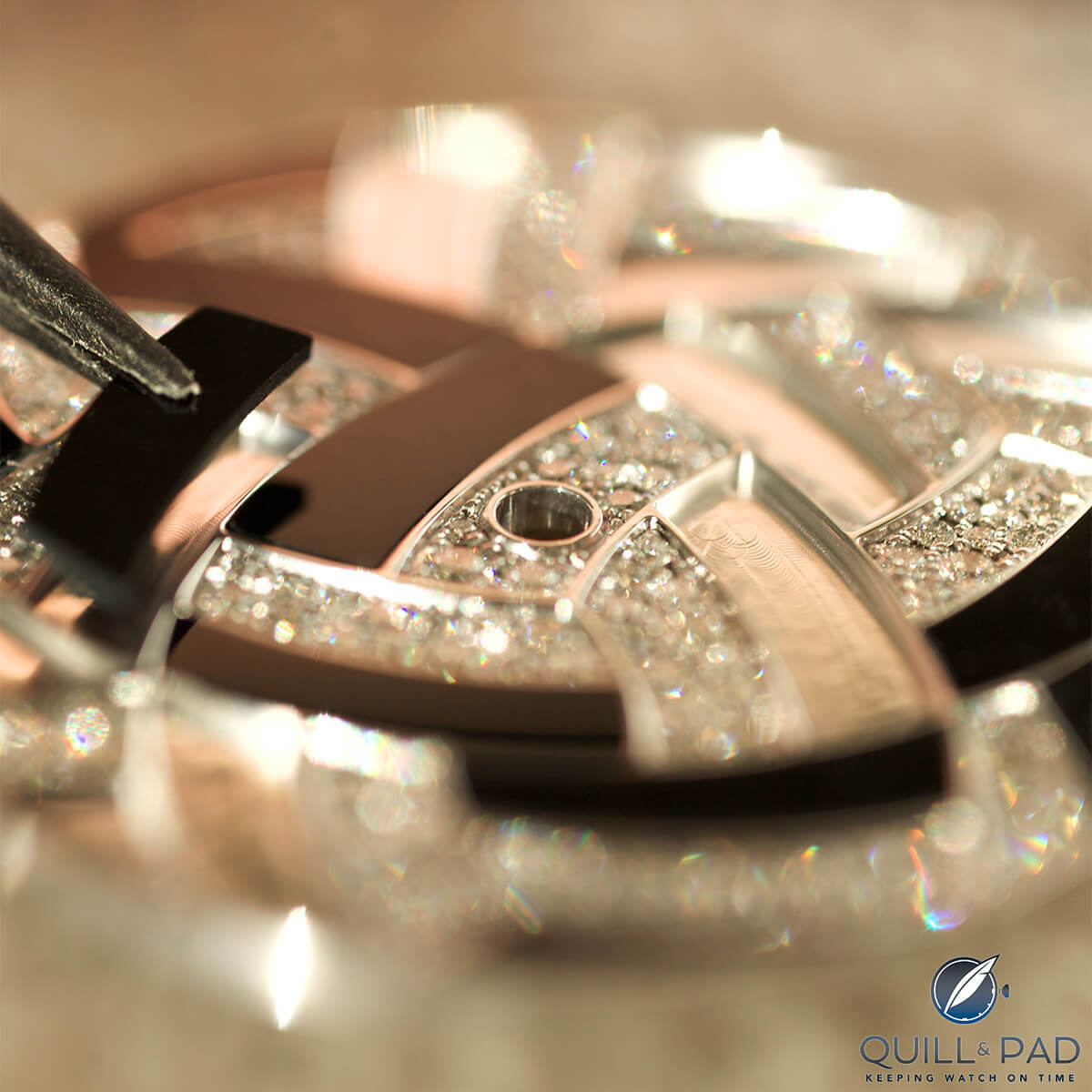
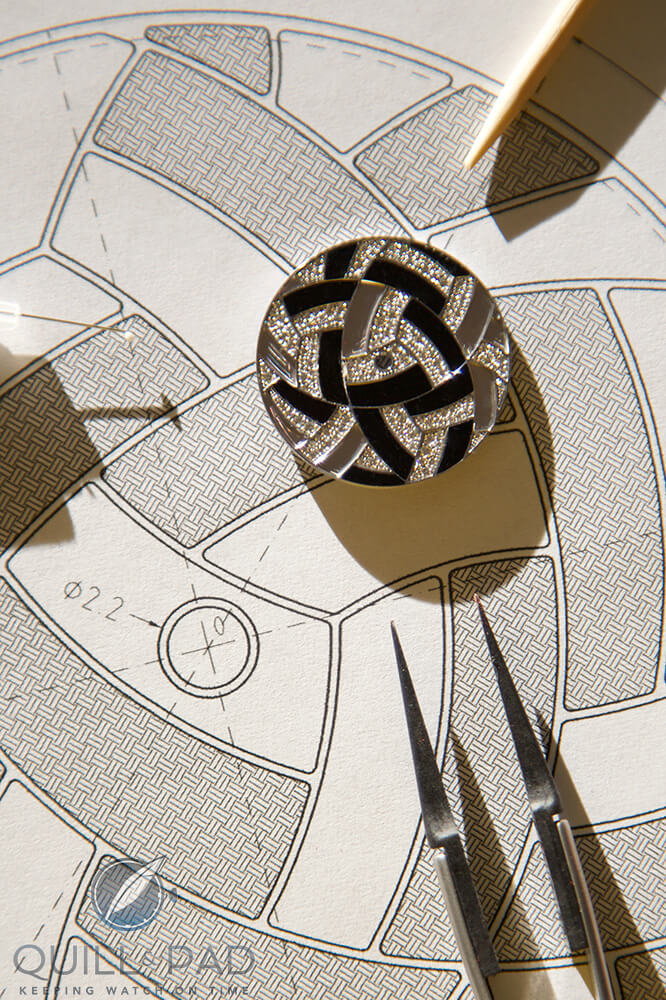
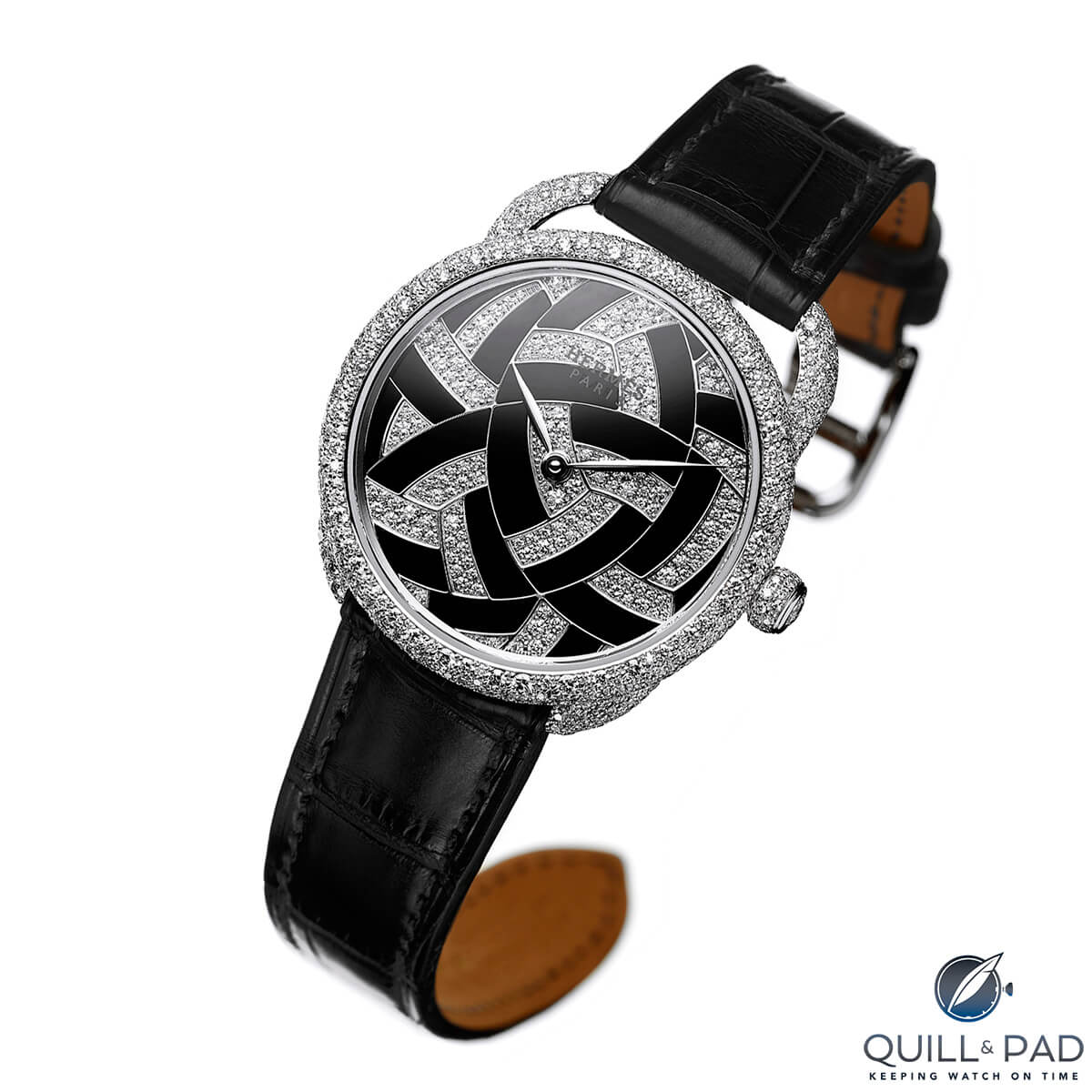
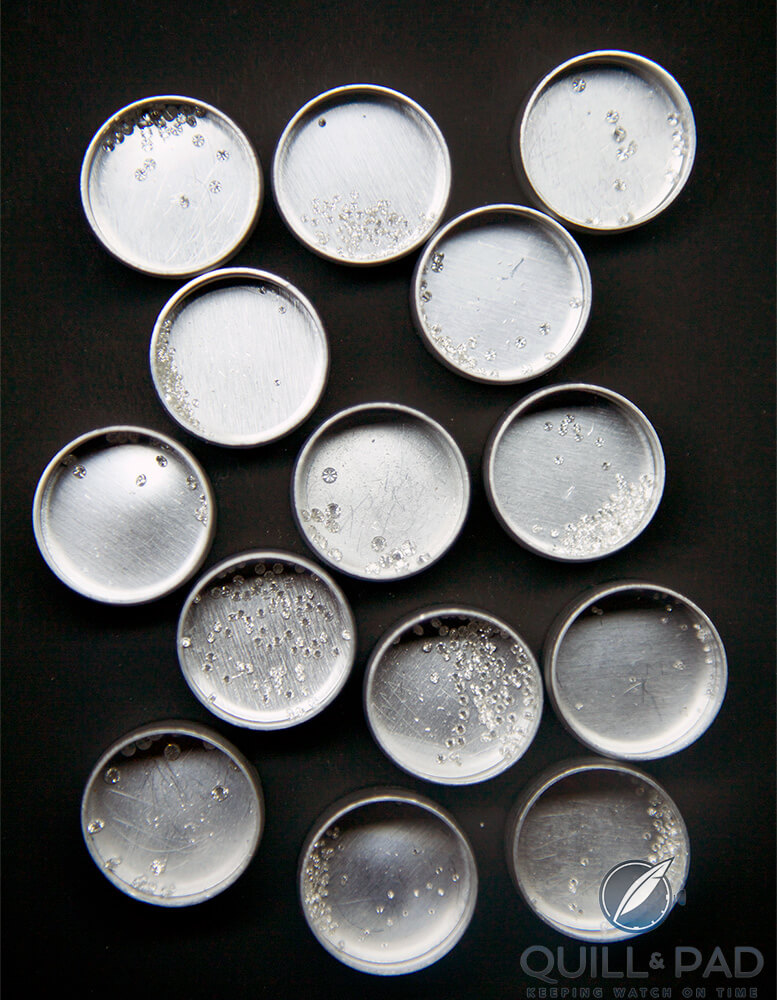
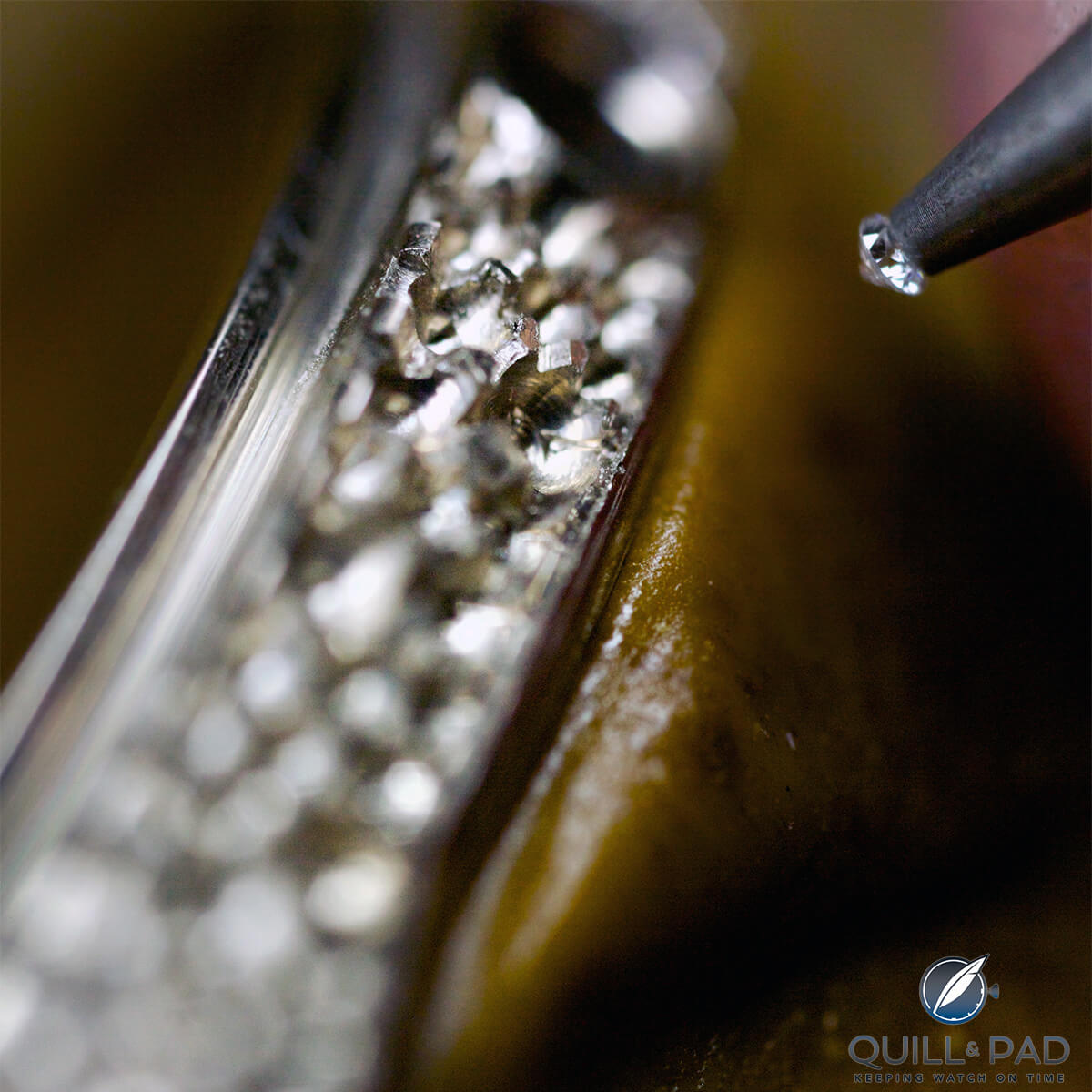
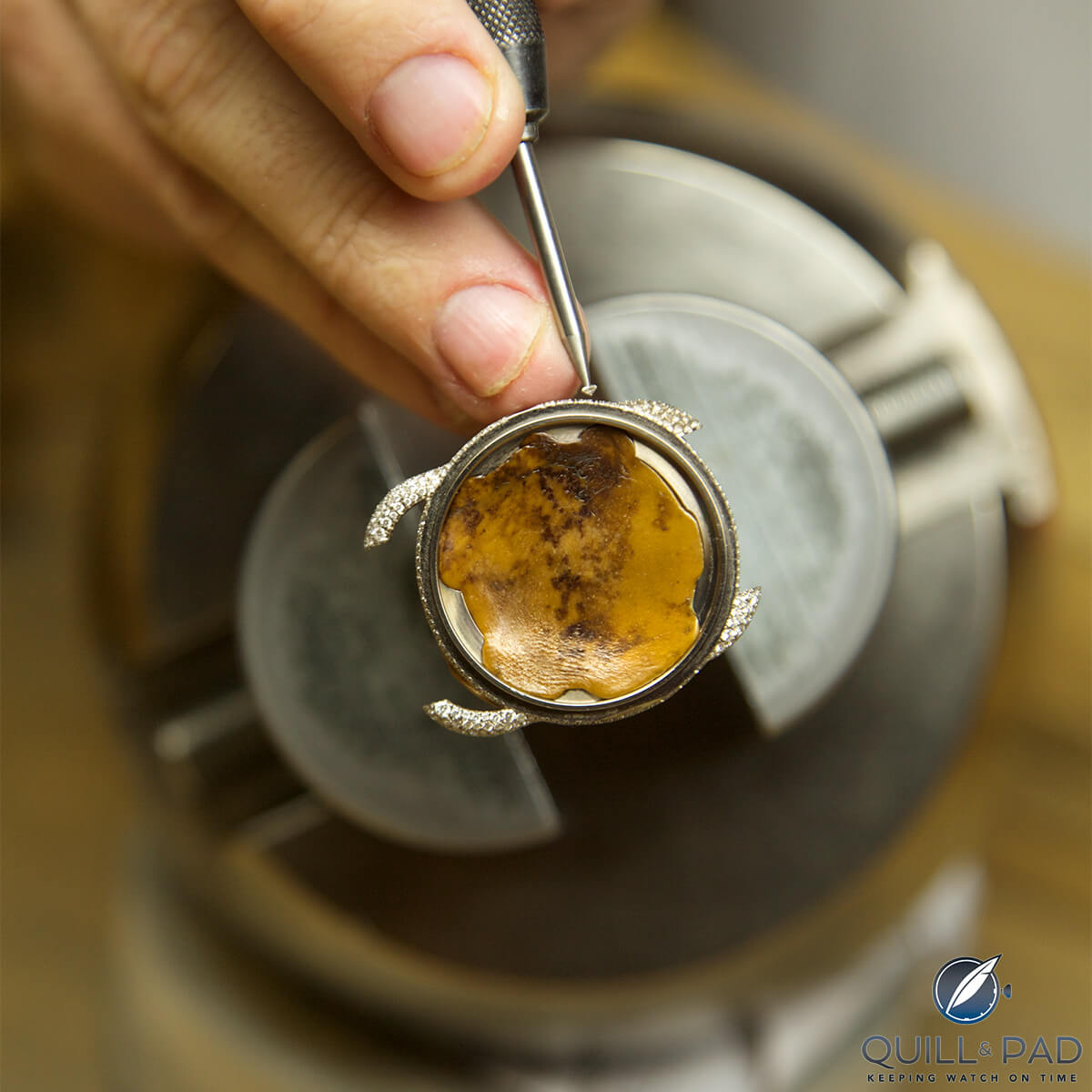
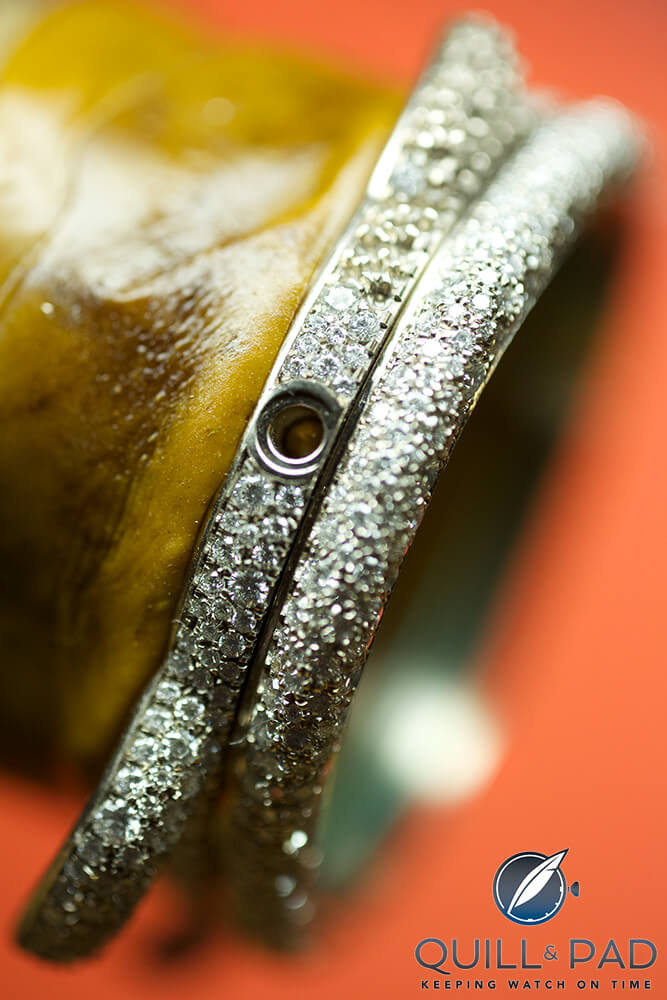
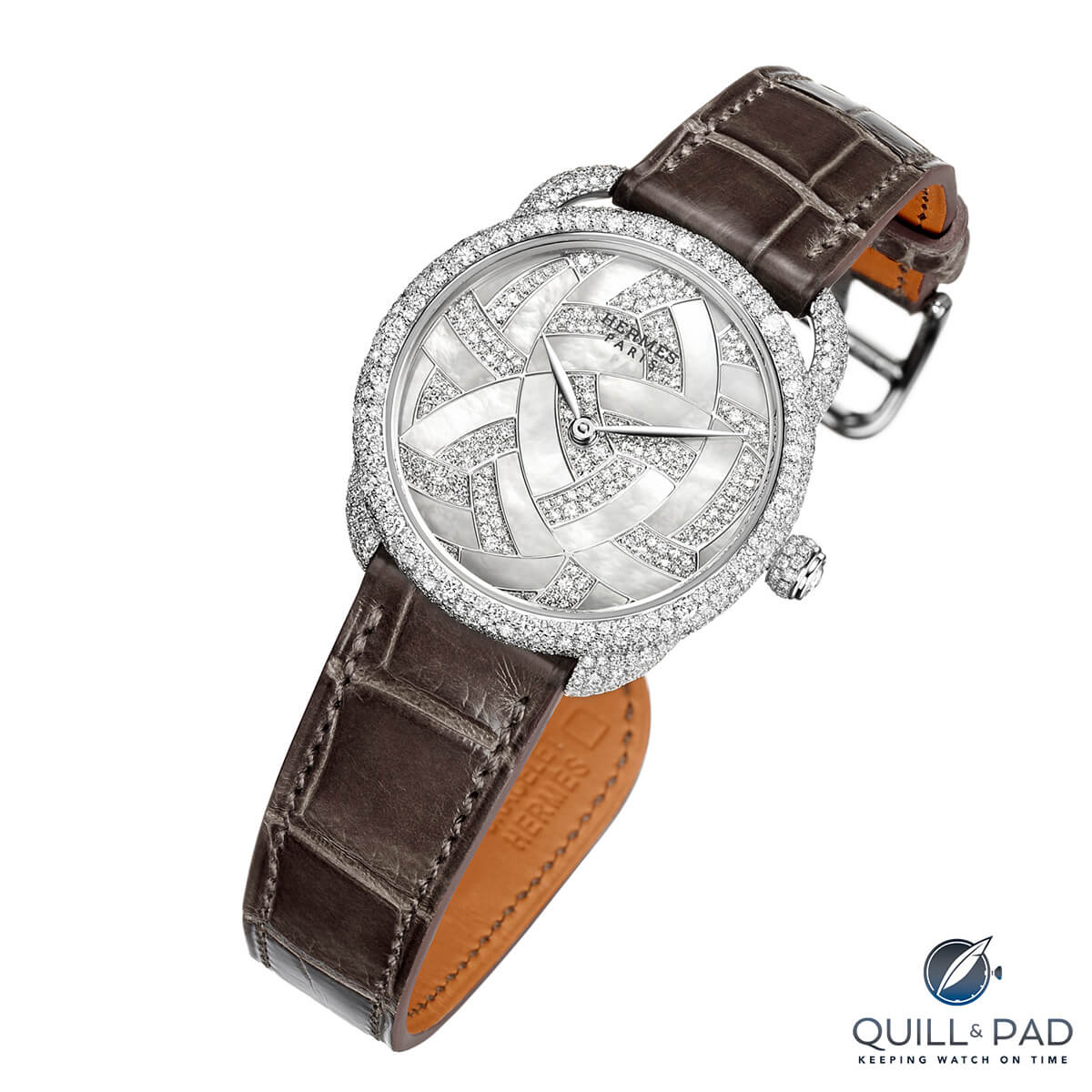
Trackbacks & Pingbacks
[…] I have said I would wear a women’s watch before (see The Hermès Arceau Temari: Stones Here And Stones There), I only adore this one as a spectator seeing as how my wrists are still rather manly. Oh, […]
[…] (crystal making), Roaring Into Life At Full Gallop: Hermès Arceau Tigre Email Ombrant (enameling), The Hermès Arceau Temari: Stones Here And Stones There (gem setting), and Introducing Slim d’Hermès: The Elegant New Backbone Of The Hermès Collection […]
Leave a Reply
Want to join the discussion?Feel free to contribute!